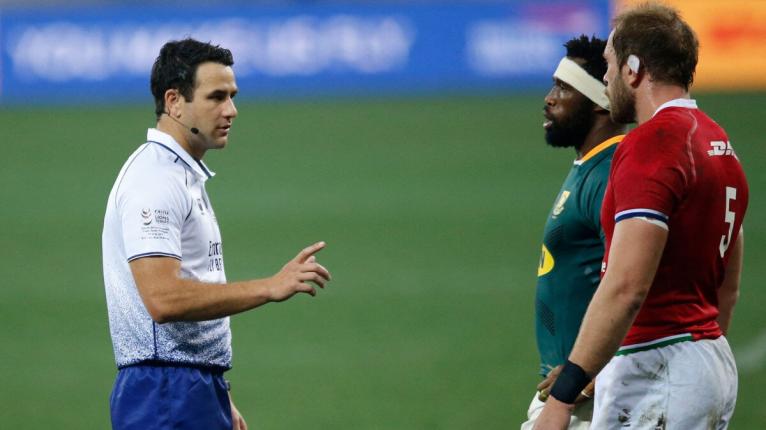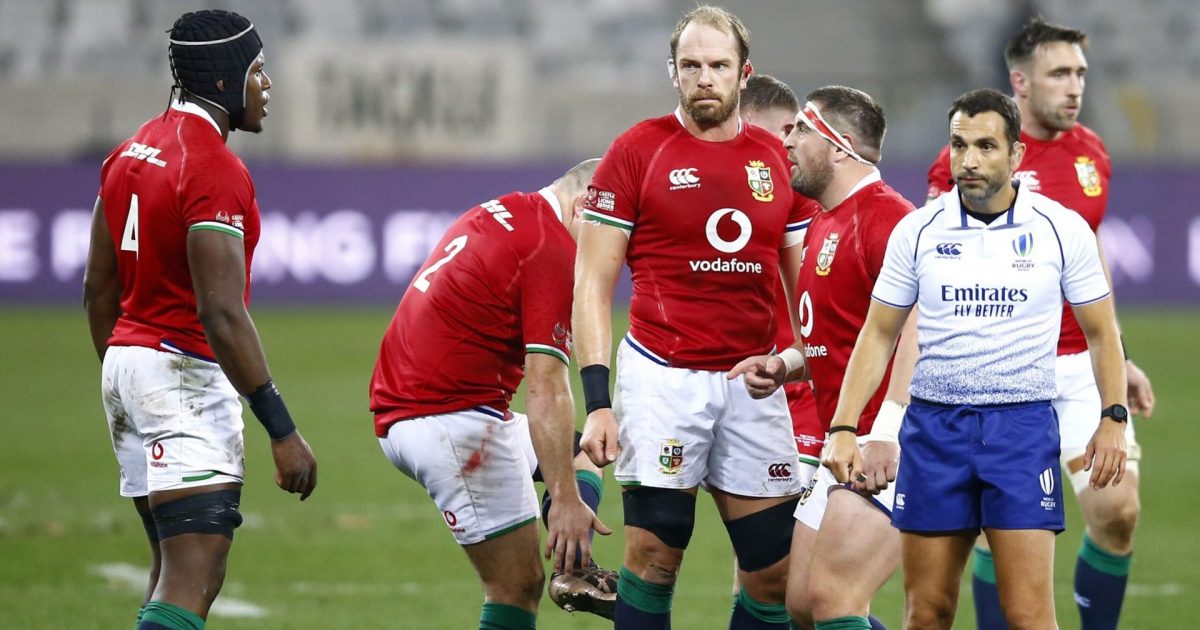Ref Watch: Kolbe try, Sinckler scrum pen and the lesson learned by the officials

“The biggest match outside the World Cup final” was how Nigel Owens described third test referee Mathieu Raynal’s challenge – and the French official will reflect afterwards that his performance in Cape Town did his prospects of being involved in the big one at France 2023 no harm whatsoever.
Such a tight contest will always have plenty of talking points, but from an officiating perspective Raynal was not at the centre of any huge controversies. When post-series analysis is done, Liam Williams’ missed two-on-one and Tom Curry needlessly giving away a penalty when the Lions were rumbling towards the home line will be subject to much more finger-pointing than the refereeing.
Despite operating in his second language, Raynal’s communication with the captains and his team of assistants was just about faultless and his calm management style was ideally suited to the occasion. As a result we had no yellow cards and very little rancour.
The Big Calls
Three refereeing decisions ended up being of crucial significance in the outcome of the match – and therefore the series.
Sinckler Scrum Penalty
With eight minutes remaining the Lions were pressing for a try which (if converted) would have taken them four points ahead of the Springboks.
When Mako Vunipola was held in goal – a call Raynal made confidently without recourse to the TMO – the visitors fed an attacking five-metre scrum close to the home posts.
Two resets later replacement tight head Kyle Sinckler was penalised for going to ground with his outside knee.
In commentary former World Cup final ref Nigel Owens described the call as “harsh” suggesting a reset would have sufficed.
However, there was little doubt that the Bristol prop was first to ground, and having already reset the match’s eleventh scrum twice it was easy to see why Raynal was reluctant to hedge his bets for a third time.
A 50-50 call but not an incorrect one for me.
The 2025 tour to Australia was a post-game topic in Cape Town, Warren Gatland getting asked if he will be available to coach and what needs to change in the build-up for that series to be a success #LionsTour2021 #LionsRugby #BoksvLions #CastleLionsSerieshttps://t.co/SxzaLzPtQ0
— RugbyPass (@RugbyPass) August 7, 2021
Kolbe Try
The amount and duration of the TMO’s reviews in the second test was clearly a source of frustration to the Lions – who wanted a higher tempo contest which they believed would suit their greater mobility and match fitness.
And from a neutral’s perspective a 63-minute half is undoubtedly not adding to the quality of the spectacle.
🎙 | "He's in the series now!"
Is there anyone better in this sort of situation than Cheslin Kolbe? 🔥 pic.twitter.com/Rxlyu7iZN9
— Sky Sports Rugby Union (@SkySportsRugby) August 7, 2021
It was therefore something of a relief that the TMO was only called into action with the clock off on three occasions with Raynal instead opting for a number of ‘behind the scenes’ checks while play continued.
The most critical of the three stoppages was the lengthy examination of home no.8 Jasper Wiese’s possible aerial knock-on in the period immediately prior to Cheslin Kolbe’s counter-attack try.
After several replays Raynal eventually grasped the nettle and advised TMO Marius Jonker “there is no clear evidence of a knock on” before awarding the try.
I thought this was also a 50-50 call, but with the ten-metre line available to assist I concurred with the view that the ball had gone up and down rather than forwards following its contact with Wiese’s upper arm and shoulder.
It is also interesting to speculate how the team of officials – who took charge of all three test matches – may have learned from their handling of a similar situation during the first test.
On that occasion the fact that there was neither clear evidence (nor helpful pitch markings) to prove that Willie le Roux was ahead of Lukhanyo Am’s chip did not stop Jonker chalking off a South African try.
The fact that Raynal repeatedly used the phrase “no clear evidence is available” suggests to me that the match official group had this particular aspect of the TMO protocol drilled into them following the criticism they rightly received.
PLAYER RATINGS: It may have been their day but there were plenty of below-par performances. #CastleLionsSeries #RSAvBIL #LionsRugby https://t.co/pglwR5olbW
— RugbyPass (@RugbyPass) August 7, 2021
Curry Maul Offside
The Lions backed up a period of first half territorial dominance with Ken Owens’ driving lineout score and when they quickly went to the corner for a second time they seemed likely to repeat the dose.
However, with the maul moving towards the home line Raynal spotted Curry release his bind and shift his position in front of the ball-carrier so he could block Siya Kolisi’s defensive effort.
In law, once the Sale flanker has lost his arm-and-hand grip he has left the maul and is required to rejoin at the hindmost foot. By failing to comply with this he was offside.
Had Raynal failed to spot this in real time it is interesting to speculate whether the TMO would have intervened since maul obstruction is far from clear cut.
| Quarter 1 | Quarter 2 | Quarter 3 | Quarter 4 | |
Pens against SA | 4 | 3 | 0 | 5 |
| Pens against BIL | 2 | 5 | 3 | 4 |
In the Spotlight
The officials have been put in the spotlight to a greater extent than ever before during this series thanks to the Rassie Erasmus hour-long first test video critique and a series of back-and-forth media exchanges between the two sets of management.
As I wrote last week, Ben O’Keefe responded brilliantly when taking charge of the second test, and Raynal should be equally satisfied with his contribution seven days on.

On the stroke of half time, viewers were given a nice insight to just how jumpy the background noise has made the officials.
Despite being no more than two metres from Wiese’s low level ruck clear-out Raynal asked Jonker to check whether it was legal.
The TMO had no camera angles remotely as good as that of the referee – who quickly recovered his composure, blew for half time and with a nice touch of humility acknowledged: “I was wrong on the pitch.”
Russell Head Contact
Finn Russell saw red for a high tackle in the Six Nations, and he must have been concerned for a few seconds when the TMO was called into action following his contact with Kolbe’s head.
But in a textbook use of the head contact protocol, Raynal used slo-mo replays to establish that the Springbok winger had slipped and as a result significantly lowered the height of his body position immediately prior to Russell making contact.
This provided the ref with enough of a mitigating factor to correctly downscale the resulting sanction to a penalty. It was also interesting to hear him advise Alun Wyn Jones that the Scotland no.10 had taken an unnecessary risk by making his challenge at chest height – a message which seems to be taking an age to gain acceptance among players.
"Congratulations to South Africa"
– Lions coach Warren Gatland has held his last media briefing as the 2021 tour head coach following his team's 19-16 loss to the Springboks in Cape Town#LionsTour2021 #LionsRugby #BoksvLions #CastleLionsSerieshttps://t.co/2cvdLYlIRi
— RugbyPass (@RugbyPass) August 7, 2021
Anorak Corner
This week’s entry came with Raynal’s second half threat to upgrade any further lineout free kicks awarded for the technical offence of ‘closing the gap’ to penalties.
Law permits the referee to treat repeat offences as persistent infringement and award a penalty even when in their own right they are only deemed worthy of a free kick.
Raynal’s excellent communication of this to the captains – whose sides had both been guilty of closing the gaps twice – had the desired effect since there was no fifth lineout infringement.
Small Margins
Raynal correctly allowed an onside Eben Etzebeth to come round the side of a seventh-minute Lions ruck and steal the ball after Wyn Jones flopped on the ball at the base without binding.
“Red is not binding anymore” was his extremely clear advice.
But when the influential Springbok lock tried a repeat early in the fourth quarter he was correctly pinged for offside since the Lions pack were bound over the ball.
Small margins – and a good insight into the concentration levels required to officiate in this white hot environment.

























































